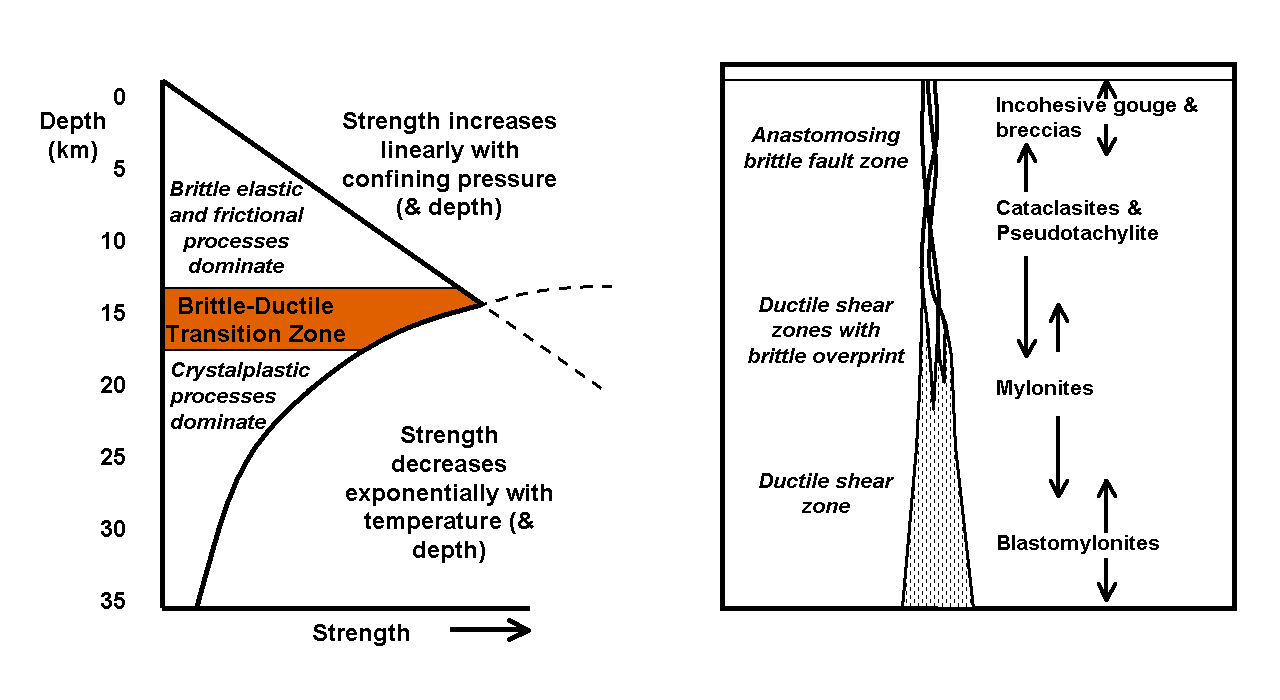
Brittle-ductile transition zone
Encyclopedia

Crust (geology)
In geology, the crust is the outermost solid shell of a rocky planet or natural satellite, which is chemically distinct from the underlying mantle...
. For quartz
Quartz
Quartz is the second-most-abundant mineral in the Earth's continental crust, after feldspar. It is made up of a continuous framework of SiO4 silicon–oxygen tetrahedra, with each oxygen being shared between two tetrahedra, giving an overall formula SiO2. There are many different varieties of quartz,...
and feldspar
Feldspar
Feldspars are a group of rock-forming tectosilicate minerals which make up as much as 60% of the Earth's crust....
rich rocks in continental crust
Continental crust
The continental crust is the layer of igneous, sedimentary, and metamorphic rocks which form the continents and the areas of shallow seabed close to their shores, known as continental shelves. This layer is sometimes called sial due to more felsic, or granitic, bulk composition, which lies in...
this occurs at an approximate depth of 13–18 km (roughly equivalent to temperatures in the range 250-400°C). At this depth rock becomes less likely to fracture
Fracture
A fracture is the separation of an object or material into two, or more, pieces under the action of stress.The word fracture is often applied to bones of living creatures , or to crystals or crystalline materials, such as gemstones or metal...
, and more likely to deform ductilely
Ductility
In materials science, ductility is a solid material's ability to deform under tensile stress; this is often characterized by the material's ability to be stretched into a wire. Malleability, a similar property, is a material's ability to deform under compressive stress; this is often characterized...
by creep
Creep (deformation)
In materials science, creep is the tendency of a solid material to slowly move or deform permanently under the influence of stresses. It occurs as a result of long term exposure to high levels of stress that are below the yield strength of the material....
. This happens because the brittle strength of a material is increased by the confining pressure, whilst the ductile strength of a material decreases with increasing temperature. The transition zone occurs at the level in the crust where the downwards increasing brittle strength equals the upwards increasing ductile strength, giving a characteristic "saw-tooth" crustal strength profile. This zone is, therefore, the strongest part of the crust and the depth at which many earthquakes occur. The level of the transition zone depends on both strain rate and temperature gradient, being shallower for slow deformation and/or high heat flow and deeper for fast deformation and/or low heat flow. Crustal composition will also affect the depth at which this zone occurs.
Sections of fault zones once active in the transition zone, and now exposed at the surface, typically have a complex overprinting of brittle and ductile rock types. Cataclasite
Cataclasite
Cataclasite is a type of cataclastic rock that is formed by fracturing and comminution during faulting. It is normally cohesive and non-foliated, consisting of angular clasts in a finer-grained matrix.- Types of cataclasite :...
s or pseudotachylite
Pseudotachylite
Pseudotachylite is a fault rock that has the appearance of the basaltic glass, tachylyte. It is dark in color and has a glassy appearance. However, the glass has normally been completely devitrified into very fine-grained material with radial and concentric clusters of crystals...
breccias with mylonite
Mylonite
Mylonite is a fine-grained, compact rock produced by dynamic recrystallization of the constituent minerals resulting in a reduction of the grain size of the rock. It is classified as a metamorphic rock...
clasts are common, as are ductily deformed cataclasites and pseudotachylites.
See also
- Seismogenic layerSeismogenic layerThe seismogenic layer is the range of depths within the crust or lithosphere over which most earthquakes are initiated. Typically in continental crust this is in the uppermost 15 km...
- Ductile Brittle Transition Temperature in materials science

